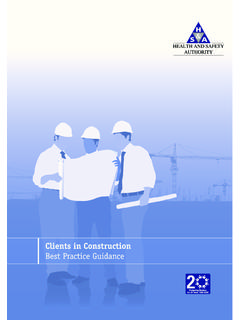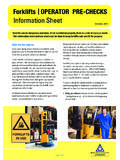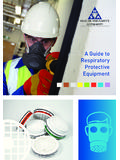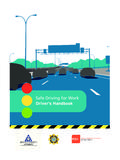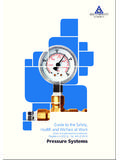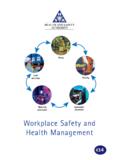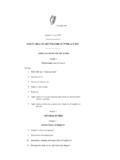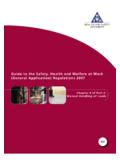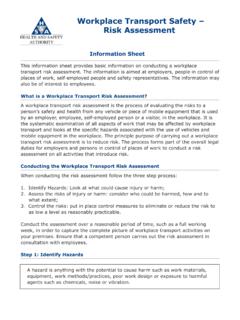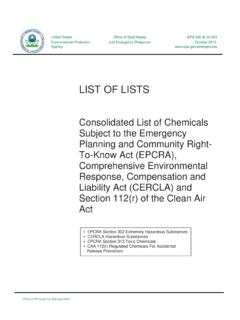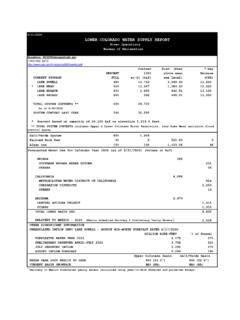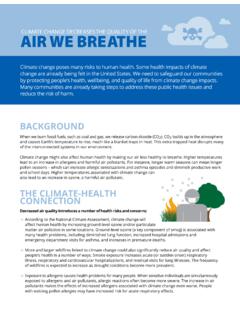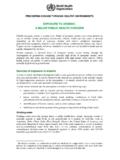Transcription of FORKLIFT SAFETY TIPS - Health and Safety Authority
1 Information SheetForklifts are extremely useful workplace vehicles, as long as they are used safely and appropriatelyby operators who are appropriately trained and competent to use them. Forklifts can be dangerous: they account for 25% of injuries at work. Many workplace accidentsinvolve people being hit or run over by FORKLIFT trucks (typically when the FORKLIFT is reversing)because the driver did not see them. Owing to their size and weight, injuries resulting from forkliftsare generally very serious. Accidents involving them are often caused by poor supervision and alack of following FORKLIFT SAFETY tips will help you and those you work with stay safe around SAFETY TIPS December, 2013 What is a FORKLIFT ?
2 A FORKLIFT is a powered truck used to carry, lift, stack ortier materials. They include pallet trucks, rideroperated forklifts, fork trucks, or lift can be powered by electric battery orcombustion are subject to statutory examination by acompetent person once every 12 months inaccordance with 299 of 2007 ( SAFETY , Health andWelfare at Work (General Application) Regulations2007).This period becomes 6 months if the FORKLIFT isused to lift the law requiresIf you own, lease, hire or borrow a vehicle for workpurposes, you must make sure that it is safe for use andfit for the purpose for which it is intended.
3 Under Health and SAFETY legislation, a vehicle is a placeof work. The law requires that workplaces aremaintained in a condition that is safe and without riskto SAFETY and Health . Vehicles must be kept safe and fitfor purpose and the driver must be able to get in andout of the vehicle safely. Forklifts also are classed as work must make sure that drivers are familiar withthe vehicle they are driving and that they have beengiven appropriate instruction, information andtraining to carry out required pre-checks and to use the vehiclein the correct and safemanner, as per themanufacturer s instructions.
4 Page 1 of 6 Employers must also make sure that they have adefect reporting system in place so that when defectsare found that they are rectified. Employees shouldnever be required to operate under conditions thatare unsafe or that do not comply with the law. Employers must make sure that forklifts are providedin a safe condition for use at work. This can beachieved by having a preventative maintenancesystem which includes scheduled checks as per themanufacturer s have legal duties to use work equipmentin a safe manner in line with procedures developed bytheir employer.
5 Safe OperationAlways: Wear appropriate personal protective clothing as provided by employer. Hard hat, protective footwear and high visibility clothing are recommended as a minimum when working aroundforklifts. Other equipment may be needed depending on the working environment Carry out a pre-shift check of the FORKLIFT Report defects immediately to supervisor Make sure work path is free of obstructions Wear operator restraints, where fitted Look all around before moving off Look in the direction of travel Travel at a speed suitable for the location and the load carried Travel with the forks lowered, but clear of the ground Watch out for pedestrians Avoid sudden stops and violent braking Take care when driving on wet, icy.
6 Slippery or loose surfaces Slow down at corners, doorways, and at danger spots Sound the horn several times when approaching blind corners, exits and entrances Switch off and remove the key before leaving the FORKLIFT . Place the key in a safe location when driving task is completed Apply the parking brake before leaving the FORKLIFT Face the FORKLIFT and use the steps and handholds when getting in or out of the vehicle. Use three points of contact Report any accidents or near misses to a supervisorNever: Operate a FORKLIFT unless you are trained, competentand authorised to do so Use a FORKLIFT or equipment you know is not working properly Operate controls from outside the cab.
7 Unless it is designed so you can do this Stand on or near the controls to reach the load or anything outside the cab Start or stop suddenly Make abrupt or quick turns travel on uneven ground unless the FORKLIFT is suitable for this Run over unprotected cables or flexible pipes Try to carry out repairs leave this to a qualified maintenance engineer Operate a FORKLIFT when under the influence of alcohol or drugs [prescribed or illegal] Use mobile phones or other hand-held devices while operating the FORKLIFT Use uncertified attachments Use an attachment unless a competent person, an authorised dealer, or manufacturer has derated the FORKLIFT [reduced actual capacity] FORKLIFT SAFETY TIPS Information SheetPage 2 of 6 FORKLIFT SAFETY TIPS Information SheetCarrying LoadsAlways: Assess the load before lifting.
8 Check weight, size, load centre and security Make sure that pallets are in good condition Observe floor loading limits Find out the weight of the laden FORKLIFT Check safe working load (SWL) of racking before placing loads onto it Make sure load does not obstruct view. If it does, drive in reverse, looking in direction of travel Make sure there is adequate clearance for the FORKLIFT and load, including overhead Make sure the load does not exceed capacity of FORKLIFT Make sure the load is stable and can be safely lifted Carry the load as close to ground as possible Use controls smoothly Position forks properly and as widely as possible Make sure the fork arms are fully inserted when travelling with a load Make sure the FORKLIFT is stopped before raising the load Use suitable attachments for lifting unusual or wide loads Lower loads at a safe speed Make sure you are properly trained.
9 Certified and authorised to operate the FORKLIFT with an attachmentNever: Lift loads greater than the capacity of the FORKLIFT Move a load that appears unsuitable or unstable (including on a damaged pallet) Lift load with attachments, unless trained, certified and authorised to do so Travel with a bulky load that blocks your view Travel with a raised load, unless the FORKLIFT is designed specifically for this Leave the vehicle with the load on SlopesAlways: Travel slowly when going down slopes Ensure the forks face uphill when travelling up or down slopes with a load Ensure the forks face downhill when travelling up or down slopes without a load Adjust the tilt (where fitted) to suit the gradient andraise the forks to clear the groundPage 3 of 6 FORKLIFT SAFETY TIPS Information SheetNever: Turn the vehicle around on or travel across a ramp or a slope Leave a FORKLIFT on a slope, except in an emergency.
10 In case of emergency always chock the wheelsCarrying PeopleAlways: Use a safe work method when using working platforms, integrated platform. Use of non-integrated platforms should only be permissible in exceptional circumstances under documented controls Remain in control of the FORKLIFT while workers are on the platform Watch out for pedestrians Use spotters when operating in congested areasNever: Lift a person on the forks or on a pallet, or similar, balanced on the forks Move travel or turn with a person lifted at height Carry passengers, unless the FORKLIFT is designed for this and has a designated seat and seat belt Allow people to walk under raised forks or loads Leave a truck unattended when people are using a non-integrated platform Pick up a load if someone is standing close to itWhen you have finished workingAlways: Park the FORKLIFT in a safe place, on level ground.
